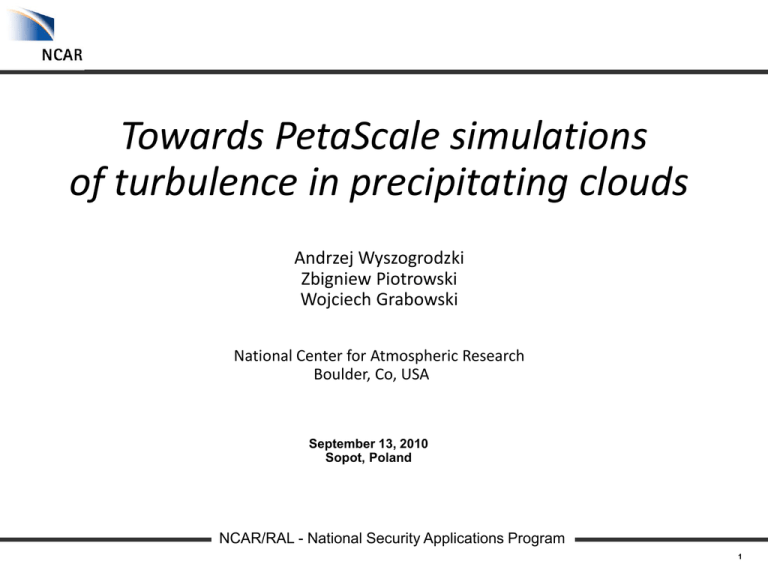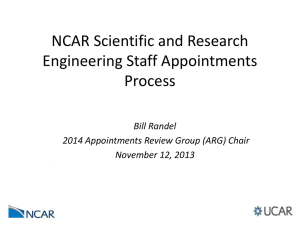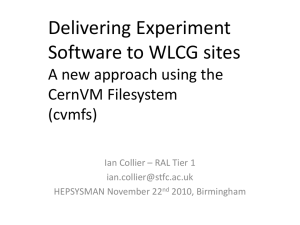PPT
advertisement

Towards PetaScale simulations of turbulence in precipitating clouds Andrzej Wyszogrodzki Zbigniew Piotrowski Wojciech Grabowski National Center for Atmospheric Research Boulder, Co, USA September 13, 2010 Sopot, Poland NCAR/RAL - National Security Applications Program 1 Multiscale interactions in atmospheric clouds The turbulent kinetic energy flows from cloud-scale motion to dissipative eddies Latent heat energy flows from individual droplets to cloud-scale motion. typical cloud of dimension 1 km could consist of O(1017) droplets NCAR/RAL - National Security Applications Program 2 Cloud Turbulence Full spectrum of scales divided into two ranges: LES and DNS Bin-based microphysics Limitation to low Reynolds numbers NCAR/RAL - National Security Applications Program 3 Cloud Turbulence Full spectrum of scales divided into two ranges: LES and DNS Filling the gap by LES and DNS models: e.g. turbulent enhancement of the collision kernel for broad range of dissipation rates NCAR/RAL - National Security Applications Program 4 Cloud Turbulence Full spectrum of scales divided into two ranges: LES and DNS LES and DNS models needs to efficiently use Peta Scale computer srchitectures NCAR/RAL - National Security Applications Program 5 Peta-scale systems NCAR/RAL - National Security Applications Program 6 TOWARD PETA SCALE COMPUTING Power 5/6/7 Blue Gene/L/C/P/Q Power PC 440/450 Trading the speed for lower power consumption Dawning Information Industry insists on the pattern of in-house technological innovation NCAR/RAL - National Security Applications Program 7 TOWARD PETA SCALE COMPUTING Current systems available for us Franklin - Cray XT4 (NERSC) 38,128 Opteron cores peak performance - 352 Tflops #17 @ Top500 IBM Blue Gene/L (NCAR) 700MHz PowerPC-440 CPUs 4096 compute nodes – 8192 cores 22.9 TFlops IBM Bluefire (NCAR) 4,096 POWER6™ 4.7 GHz processors 77 Tflops, #90 @ Top500 Hopper – Cray XT5 (NERSC) 2 quad-core AMD 2.4 GHz processors 5312 total cores Lynx - Cray XT5m (NCAR) 2 hex-core 2.2 GHz AMD Opteron 912 cores 8.03 TFLOPs NCAR/RAL - National Security Applications Program 8 TOWARD PETA SCALE COMPUTING PetaScale systems in near future Late summer 2010 Hopper II – Cray XE6 (NERSC) 2 twelve-core AMD 'MagnyCours' 2.1 GHz 153,408 total cores >1 PetaFlop peak performance IBM Cyclops-64 (C64) / BlueGene/C 80/160 processors (or cores) per chip 80 Gflops/chip 13.824 nodes (2.211.840 cores total) 1.1 PetaFlops 2011 IBM Blue Waters (NCSA) ~10 Petaflops peak > 1 Petaflops sustained IBM Blue Gene/Q – Sequoia LLNL, 2011-2012 98,304 nodes - 1.6 million cores ~20 Petaflop peak NCAR/RAL - National Security Applications Program 9 EULAG PARALLELIZATION HISTORY 1996-1998: compiler parallelization on NCAR’s vector Crays J90 1996-1997: first MPP (PVM)/SMP (SHMEM) version at NCAR’s Cray T3D based on 2D domain decomposition (Anderson) 1997-1998: extension to MPI, removal of PVM (Wyszogrodzki ) 2004: attempt to use OpenMP (Andrejczuk) 2009-2010: development of OpenMP and GPU/OpenCL version (Rojek & Szustak) 2010: extending 2D decomposition to 3D MPP (Piotrowski & Wyszogrodzki) NCAR/RAL - National Security Applications Program 10 Data decomposition in EULAG CPU CPU CPU CPU CPU CPU CPU CPU CPU CPU CPU CPU CPU CPU CPU halo boundaries in x direction (similar in y direction – not shown) j - index CPU i - index 2D horizontal domain grid decomposition No decomposition in vertical Z-direction Hallo/ghost cells for collecting information from neighbors Predefined halo size for array memory allocation Selective halo size for update to decrease overhead NCAR/RAL - National Security Applications Program 11 Typical processors configuration Computational 2D grid is mapped onto an 1D grid of processors Neighboring processors exchange messages via MPI Each processor know its position in physical space (column, row, boundaries) and location of neighbor processors NCAR/RAL - National Security Applications Program 12 EULAG – Cartesian grid configuration In the setup on the left nprocs=12 nprocx = 4, nprocy = 3 if np=11, mp=11 then full domain size is N x M = 44 x 33 grid points Parallel subdomians ALWAYS assume that grid has cyclic BC in both X and Y !!! In Cartesian mode, the grid indexes are in range: 1…N, only N-1 are independent !!! F(N)=F(1) –> periodicity enforcement N may be even or odd number but it must be divided by number of processors in X The same apply in Y direction. NCAR/RAL - National Security Applications Program 13 EULAG Spherical grid configuration with data exchange across the poles In the setup on the left nprocs=12 nprocx = 4, nprocy = 3 if np=16, mp=10 then full domain size is N x M = 64 x 30 grid points Parallel subdomians in longitudinal direction ALWAYS assume grid in cyclic BC !!! At the poles processors must exchange data with appropriate across the pole processor. In Spherical mode, there is N independent grid cells F(N) F(1) … required by load balancing and simplified exchange over the poles -> no periodicity enforcement At the South (and North) pole grid cells are placed at y/2 distance from the pole. NCAR/RAL - National Security Applications Program 14 EULAG SCALABILITY TESTS Strong Scaling Weak Scaling n n n Total problem size fixed. n Problem size/proc drops with P Problem size/proc fixed Easier to see Good Performance n n Beloved of Benchmarkers, Vendors, Software Developers –Linpack, Stream, SPPM Beloved of Scientists who use computers to solve problems. Protein Folding, Weather Modeling, QCD, Seismic processing, CFD NCAR/RAL - National Security Applications Program 15 EULAG SCALABILITY TESTS Benchmark results from the Eulag-HS experiments NCAR/CU BG/L system 2048 processors (frost), IBM/Watson Yorktown heights BG/W … up to 40 000 PE, only 16000 available during experiment Red lines – coprocessor mode, blue lines virtual mode NCAR/RAL - National Security Applications Program 16 EULAG SCALABILITY Benchmark results from the Eulag-HS experiments NCAR/CU BG/L system 8384 processors (frost), IBM/Watson Yorktown heights BG/W … up to 40 000 PE, only 16000 available during experiment All curves except 2048x1280 are performed on BG/L system. Numbers denote horizontal domain grid size, vertical grid is fixed l=41 The Elliptic solver is limited to 3 iterations (iord=3) Red lines – coprocessor mode, blue lines virtual mode Excellent scalability up to number of processors NPE=sqrt(N*M) NCAR/RAL - National Security Applications Program 17 Problems in achieving high model efficiency Performance and scalability bottlenecks: Data locality & domain decomposition Peak performance Tradeoffs: efficiency vs accuracy and portability Load balancing & optimized processor mapping I/O NCAR/RAL - National Security Applications Program 18 Development of EULAG 3D domain decomposition (Piotrowski) Purpose: increase data locality by minimize maximum number of neighbors (messages) Changes to model setup and algorithm design - New processor geometry setup - Halo updates in vertical direction - Optimized halo updates at the cube corners - Changes in vertical grid structure for all model variables - New loops structure due to differentiation and BC in vertical NCAR/RAL - National Security Applications Program 19 EULAG 3D domain decomposition Taylor Green Vortex (TGV) system Turbulence Decay Triple periodic cubic grid box Only pressure solver and model initializations, no preconditioneer Fixed number of iterations 100 calls to solver 512^3 grid points IBM BG/L system with 4096 PEs NCAR/RAL - National Security Applications Program 20 EULAG 3D domain decomposition Decomposition patterns NCAR/RAL - National Security Applications Program 21 EULAG 3D domain decomposition CRAY XT4 at NERSC NCAR/RAL - National Security Applications Program 22 BOTTLENECK – DATA LOCALITY Nonhydrostatic, anelastic, Navier-Stokes eqns Preconditioned Generalized Conjugate Residual (GCR) solver for nonsymmetrical elliptic pressure eqn SOLUTION REQUIRES EFFICIENT PARALLEL SOLVER FOR GLOBAL REDUCTION OPERATIONS NCAR/RAL - National Security Applications Program 23 New domain decomposition ideas for elliptic solvers (J-F Cossette) How to solve the Dirichlet problem on non-trivial domains? Schwarz Alternating decomposition method: • form a sequence of local solutions found on simpler subdomains that converges to the global solution • readily extends to arbitrary partitions • used as a preconditioner in Newton-Krylov Schwarz methods (NKS) – CFD problems (e.g. low Mach number compressible flows, tokamak edge plasma fluid) NCAR/RAL - National Security Applications Program 24 New domain decomposition ideas for elliptic solvers (J-F Cossette) Discretized forms of the Schwarz method that solve the linear system use: • restriction operators (global to local) to collect boundary condition • prolongation (local to global) operators to redistribute partial solutions Additive Schwarz Restrictive Additive Schwarz method (RASM) eliminates the need for transmission conditions - faster convergence and CPU time Cai and Sarkis (1999) 2 1 3 Knoll & Keyes, 2004 Parallel computing: solution on each subdomain is found simultaneously (Lions, 1998) NCAR/RAL - National Security Applications Program 25 BOTTLENECK – PEAK PERFORMANCE Performance Gap 1000 Efficiency for many science applications declined from ~50% on vector supercomputers of 1990s to below 10% on parallel supercomputers today Peak Performance Teraflops 100 Performance Gap OPEN QUESTION: to be efficient or to be accurate: i.e. how to improve peak performance on single processor (a key factor to achieve sustained Peta performance) but not degrade model accuracy? 10 1 Real Performance - Profiling tools - Automatic compiler optimizations 0.1 1996 2000 2004 2008 EULAG: standard peak performance - Code restructurization - Efficient parallel libraries 3-10% depending on system NCAR/RAL - National Security Applications Program 26 BOTTLENECK – PEAK PERFORMANCE Scalar and Vector MASS (Math Acceleration Subroutine System) Approximate clock cycle-counts per evaluation on IBM BG/L function libm.a libmass.a libmassv.a Sqrt 159 40 11 Exp 177 65 19 Log 306 95 20 Sin 217 75 32 Cos 200 73 32 pow 460-627 171 29-48 Div 29 11 5 1/X 30 11 4/5 EULAG: increase up to 15% of peak on IBM BG/L system (optimizations in microphysics and advection), but differences in results may be expected NCAR/RAL - National Security Applications Program 27 BOTTLENECK – LOAD BALLANCING Balanced work loads: small imbalances result in many wasted processors! (e.g. 100,000 processors with one processor 5% over average workload equivalent to ~5000 idle processors) • No noticed balancing problems in Cartesian model • Unbalancing in spherical code during communication over the poles • Problem with grid partitioning in unstructured mesh model: proper criterion of efficient load balancing (e.g. geometric methods) vs workload of numerical algorithms used NCAR/RAL - National Security Applications Program 28 BOTTLENECK – PROCESSOR MAPPING Blue Gene / Cray’s XT – torus geometry 3-d Torus Torus topology instead of crossbar (e.g 64 x 32 x 32 3D torus of compute nodes) Each compute node is connected to its six neighbors: x+, x-, y+, y-, z+, zGood mapping -> reducing smaller better message latency, communication costs, scalability and performance NCAR/RAL - National Security Applications Program 29 BOTTLENECK – PROCESSOR MAPPING The mapping is performed by the system, matching physical topology Node partitions are created when jobs are scheduled for execution Processes are spread out in a pre-defined mapping (XYZT) EULAG 2D grid decomposition A contiguous, rectangular subsection of the 64 cores on compute node with shape 2x4x8 Torus topology for connecting nodes Alternate and sophisticated user defined mappings are possible NCAR/RAL - National Security Applications Program 30 BOTTLENECK - I/O Requirements of I/O Infrastructure • Efficiency • Flexibility • Portability I/O in EULAG • full dump of model variables – raw binary format • short dump of basic variables for postprocessing • Netcdf output • Parallel Netcdf • Vis5D output in parallel mode • MEDOC (SCIPUFF/MM5) NCAR/RAL - National Security Applications Program 31 BOTTLENECK - I/O Sequential I/O: all processes send data to rank 0, PE0 writes it to the file … memory constrains, single node bottleneck, limits scalability PE0 PE1 PEN FILE Memory optimization • sub-domains are sequentially saved without creating single serial domain (require reconstruction of the full domain in post processing mode) NCAR/RAL - National Security Applications Program 32 BOTTLENECK - I/O Different way: Each process writes to a separate file (e.g Netcdf) PE0 PE1 PEN FILE1 FILE2 FILEN … high performance, scalability … awkward: lots of small files to manage, difficult to read data from different number of processes NCAR/RAL - National Security Applications Program 33 BOTTLENECK - I/O Need for true scalable parallel I/O: multiple processes accessing data (reading or writing) from a common file at the same time PE1 BLOCK1 PE2 BLOCK2 PEN BLOCKN - Distributed File Systems MPI-2 I/O Pnetcdf PROBLEMS: Network bandwidth Extra coordination required on shared file pointers Some cluster parallel file systems do not support shared file pointers Portability: advanced functions in MPI-IO are not supported by all file systems NCAR/RAL - National Security Applications Program 34 OPEN QUESTIONS • How to deal with new Petascale technologies: – GPU – millions of cores (threads) • Solutions for scalable/efficient I/O • Methods to increase peak performance on single node • Efficient domain decomposition methods on parallel systems NCAR/RAL - National Security Applications Program 35






![Remarks from John Wyngaard`s colleagues and friends []](http://s2.studylib.net/store/data/005434837_1-85c946efb814a5db9caf98806f4db1a5-300x300.png)


